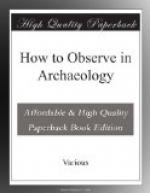The principal classes of ancient remains are as follows:
Settlements. These are usually much devastated by the removal of building materials to more recent habitations; or are obscured by modern towns and villages on the same site. All foundations in squared masonry, or composed of unusually large stones, should be noted and protected as far as possible. The frequent presence of large building stones, and especially of architectural fragments, in recent house-walls probably indicates the neighbourhood of an ancient building: and all reconstructions and fresh foundation-trenches should be kept under observation. The present Antiquity Law provides for the inspection and custody of ancient remains so exposed: the Curator of Ancient Monuments is charged with the supervision of all buildings and monuments above ground; the Keeper of Antiquities for the custody of movable objects, and for the registration of those already in private possession. Taking into consideration the utility of good building material to the present owners of such sites, active co-operation to preserve ancient masonry is not to be expected, unless local patriotism and expectation of traffic from tourists can be enlisted in support of Government regulations. Architectural fragments found in reconstruction are often best preserved by arranging that they shall be built conspicuously into one of the new walls, well above ground-level, or transferred to the nearest church or school-house.
Sanctuaries usually consist of a walled enclosure containing numerous pedestals and bases of votive statues and other monuments. Usually only the foundation-walls are of stone, as the same sun-dried brick was commonly used in ancient as in modern times for the superstructure. Such sites are often vary shallow, and when they occur in the open country are liable to be disturbed by ploughing, when the smaller statuettes and terra-cotta figures may be turned up in considerable numbers. As most of our knowledge of the sculpture, as well as of the religious observances, of ancient Cyprus is derived from such sites, all such indications should be reported at once to the Keeper of Antiquities, and arrangements made for the site to be examined with a view to excavation before it is cultivated further. The sculpture on these sites begins usually in the seventh century B.C.; before that period terra-cotta figures were in use as far back as the ninth or tenth century. Figures of ‘Mixed Oriental’ style, resembling Assyrian or Egyptian work, give place about 500 B.C. to a provincial Greek style, which passes gradually into Hellenistic and Graeco-Roman. The material is almost invariably the soft local limestone, and the workmanship is often clumsy; but even the coarser examples should be treated carefully, as they were sometimes completed in colours which are easily destroyed by too vigorous washing. The first cleaning should be with gently running water only.




